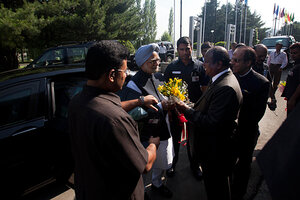Armed resistance reemerging in Kashmir
India's prime minister toured the disputed region a day after one of the deadliest attacks on Indian forces in years. India is talking up development, but political dialogue is lacking.

India's Prime Minister Manmohan Singh, center with blue turban, is greeted by Chief Postmaster General John Samuel, right presenting a bouquet, during the release of a postal stamp of Kashmiri poet Peerzada Ghulam Ahmad Mehjoor, in Srinagar, India, June 25. Shops, businesses ,and schools were closed in Indian-controlled Kashmir after separatist groups called for a strike Tuesday to protest a visit by the Indian prime minister to the disputed Himalayan region.
Dar Yasin/AP
Srinagar, Indian-administered Kashmir
Prime Minister Manmohan Singh went on with a planned visit to the deserted and barricaded city of Srinagar in Indian-held Kashmir a day after two militants attacked an Indian Army convoy here.
Eight soldiers were killed and 14 were injured in the attack, making it one of the deadliest in the resurgent Kashmiri insurgency that is slowly and deftly reemerging on Kashmir’s landscape.
After a substantial phase of people’s disenchantment with violence and a gradual movement away from an armed struggle toward nonviolent protests and social media campaigns, the gun seems to be returning to the center stage of Kashmir’s fight against Indian rule. New Delhi missed an opportunity to engage with a changed environment where the focus was on nonviolence and instead started terming the absence of violence as peace and silence of guns as Kashmir’s acceptance of the Indian rule.
The attack yesterday came a day after the killing of two policemen who were shot dead from close range by unidentified gunmen in Srinagar’s busy business hub. This year so far has already seen the death of more than 25 armed forces personnel in the territory, and a much more sophisticated militancy appears to be active in the Kashmir Valley. According to the police and Army, many of these new militants are local Kashmiri youth and they are carrying out a lot of the operations now.
“Before the Arab Spring, in 2008 and 2010, half a million Kashmiri people marched peacefully on the streets of Kashmir, seeking a solution to the Kashmir dispute and asking freedom from Indian rule. Not a single armed forces personnel was killed in these protests, but the Indian state responded with imposing curfews, stopping the Internet service, and killing more than 170 young unarmed boys, and wounding thousands,” says Asif Ahmad, a young computer science graduate, who was part of these protests and had felt that some solution was finally on its way.
“But nothing happened. Absolutely nothing. Other than thousands of young boys being send to prison for protesting and even for what they posted on facebook,” he says.
India has pursued a counterinsurgency strategy that merges police surveillance and crackdowns with local elections, jobs programs, and some development. Mr. Singh visited Kashmir today to inaugurate a rail line that will eventually link the Kashmir Valley with India – part of New Delhi's hopes of more fully integrating the disputed region with India. The relative peace of the last few years has also paid nongovernmental dividends in the form of skyrocketing tourism from India.
Yet India has made few movements toward a political process to address the long-standing Kashmir dispute.
The Himalayan region is claimed fully by both India and Pakistan, and is de facto divided by the two countries along a military Line of Control. Many Kashmiris, particularly Muslims in the Kashmir Valley, want the right to self-determination to join with India or Pakistan or to be independent. A bloody mass armed uprising, supported by militants from Pakistan, raged from 1989 into the past decade against India, which responded by maintaining more than half a million forces in the region with immunity from the law. The conflict has left some 70,000 people dead, mostly civilian.
In recent years, India has carried on a slow dialogue with Pakistan that has included some initiatives aimed at boosting trade and travel links between the two countries. But India's public outreach to Kashmiris themselves was limited to a listening tour of the region by three "interlocutors" whose recommendations for a dialogue with separatists, among other steps, went nowhere.
Without any political process to look to, there is an immense sense of siege in Kashmir and the hopelessness among the youth has increased even more after they witnessed the same violent response from the Indian state for throwing stones and chanting slogans as for picking up arms.
“The militancy had almost come to an end, and even I had thought that it was a phase that is now over. But Kashmir is a political problem, and violent and nonviolent means are only an expression of the political resentment and aspiration among the Kashmiris,” says Noor Ahmad Baba, a political science professor at Kashmir University.
Professor Baba was himself a young man during the 1990s when militancy was at its peak in Kashmir, and he feels that this is an altogether new kind of militancy that is coming up. “That time it was a mass movement and everyone picked up gun in anger and passion without knowing what it meant and what it entailed. Now it is much more sophisticated and professional, this one is going to be different,” says Baba.
Hizbul Mujahideen, a militant outfit based in Pakistan-held-Kashmir and one of the oldest organizations fighting in the region, claimed the attack on the convoy. “The attack was carried out by special squad of the outfit and our militants reached their hideouts safely,” HM’s operational spokesperson Baleeg-u-Din told a local Kashmiri news agency last night.

